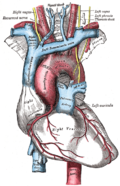Recurrent laryngeal nerve: Difference between revisions
CSV import |
CSV import |
||
| Line 36: | Line 36: | ||
{{stub}} | {{stub}} | ||
== Recurrent_laryngeal_nerve == | |||
<gallery> | |||
File:Recurrent_laryngeal_nerve.svg|Recurrent laryngeal nerve | |||
File:Gray622.png|Gray's Anatomy illustration 622 | |||
File:Gray505.png|Gray's Anatomy illustration 505 | |||
File:Rekurrens.png|Rekurrens | |||
</gallery> | |||
Latest revision as of 21:31, 23 February 2025
Recurrent laryngeal nerve
The recurrent laryngeal nerve (RLN) is a branch of the vagus nerve (cranial nerve X) that supplies all the intrinsic muscles of the larynx, with the exception of the cricothyroid muscles. There are two recurrent laryngeal nerves, right and left, in the human body.
Anatomy[edit]
The right and left recurrent laryngeal nerves differ in length and course. The right recurrent laryngeal nerve originates in the chest, loops around the right subclavian artery, and ascends into the neck between the trachea and esophagus. The left recurrent laryngeal nerve originates in the chest, loops under the aorta distal to the ligamentum arteriosum, and ascends into the neck between the trachea and esophagus.
Function[edit]
The recurrent laryngeal nerve serves to innervate the muscles responsible for the movement of the vocal cords, enabling speech, breathing, and swallowing.
Clinical significance[edit]
Damage to the recurrent laryngeal nerve can result in a weakened voice (hoarseness) or loss of voice (aphonia) and can cause difficulties in breathing and swallowing (dysphagia).
See also[edit]
References[edit]
<references />






